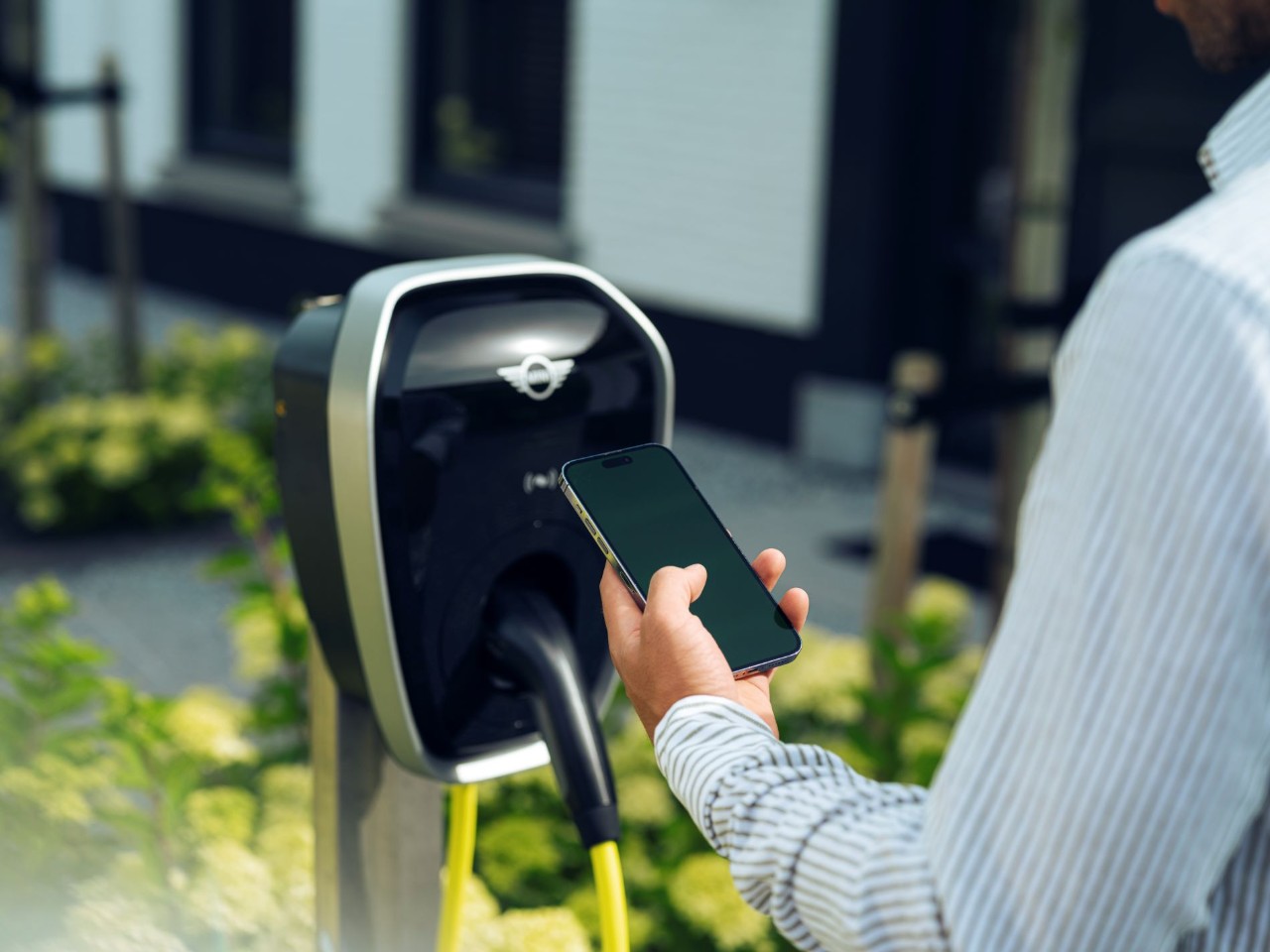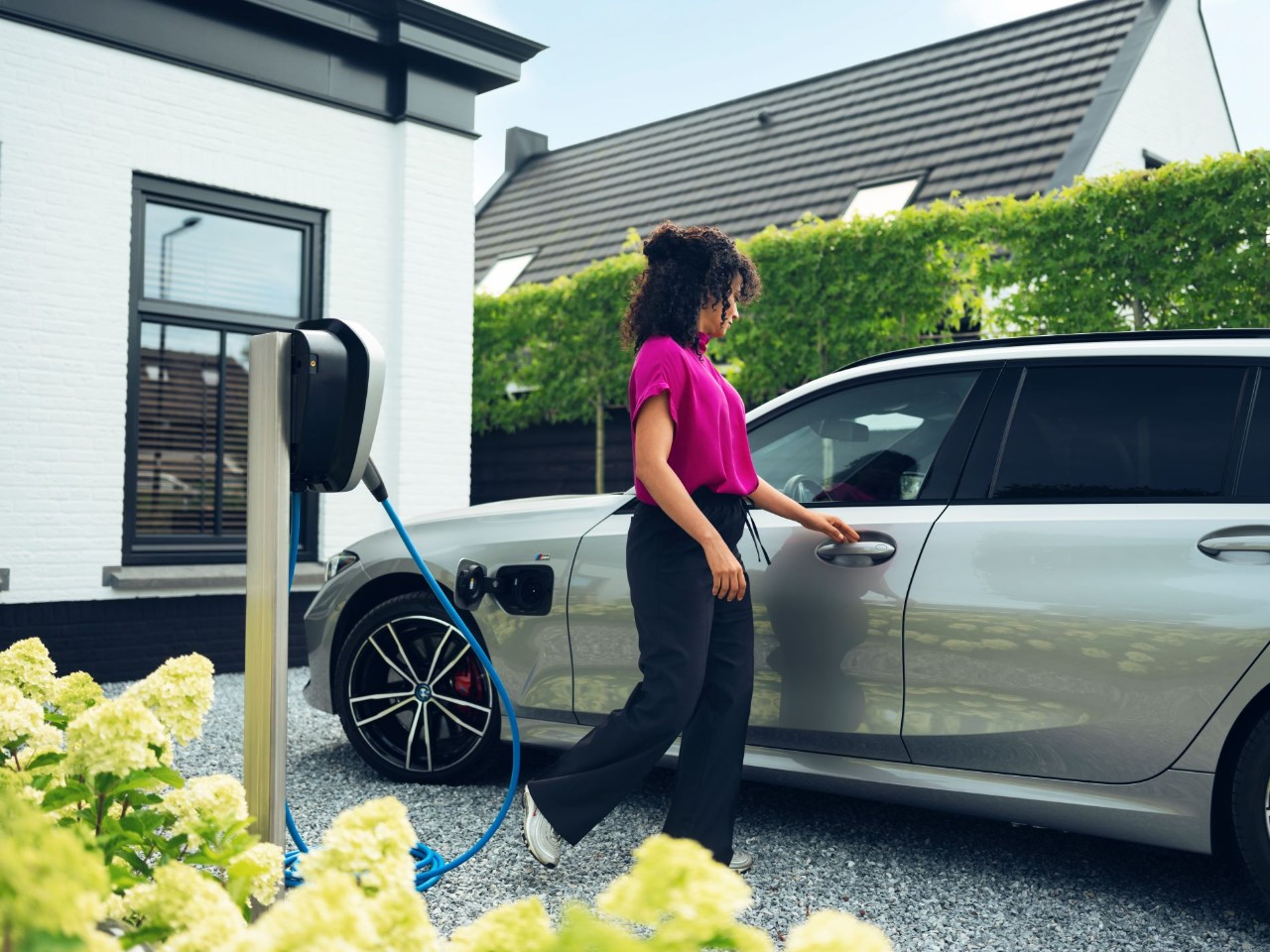Charging at home - general

You can charge your car at home via a wall socket or charging station. Charging an electric vehicle requires a lot of power. This can overload your wall socket and it is therefore not recommended to charge your EV via the wall socket. It is, however, possible for hybrid vehicles. Depending on the company you work for, a smart cable is also provided for charging at the wall socket. This cable records how much you charge and how much your company should reimburse you for the cost of electricity.
To charge your electric vehicle efficiently, safely, and quickly, you can install a charging station. Your employer probably already works with a charging infrastructure partner and can assist you with this.
The charging process for electric vehicles is pretty self-explanatory: you connect your car to the charging station or wall socket via the appropriate charging cable that came with your car. The correct charging cable when you want to charge at a charging station (regardless of whether it is public or private) is the cable with 2 equal ends. Some charging stations, and certainly the fast chargers, have a fixed cable that you can use.
For home charging at a wall socket, you can use the charging cable that has a traditional plug at one end.
For certain types of vehicles, such as hybrid vehicles, you can get a smart cable from your employer. This does not come standard with every car, but depends on each company. This type of cable records how much you charge from home and tells your employer how much the company should pay you back for your electricity consumption.
Some charging stations automatically start charging your car as soon as the car is connected, a feature known as “Plug & Charge”. If not, you can initiate the charging process using the charging card or pass provided by Alphabet or its partner, unless specified otherwise by your company.
Once your car is fully charged, stop the charging process by disconnecting it from the charging station. Finally, unplug the cable and store it in your car.
Please note that most cars will not allow you to unplug the charging cable unless the car is unlocked.
Your smart home charging station tracks the amount of electricity (in kWh) used to charge your vehicle. Based on this data, the charging point operator reimburses you a fixed amount per kWh each month. While you continue to pay your energy supplier, you receive compensation for the portion used to charge your vehicle. We recommend increasing your monthly instalments to prevent any unexpected costs on your final bill. The amount that our partner reimburses will be charged to your employer via the lease contract.
Please note: A charging station only becomes active in the systems of the charging point operator after inspection. The settlement of electricity credits is therefore only applicable once the charging point has been approved.
The reimbursement of the electricity consumed when charging at home can be done in two ways:
Via actual costs:
In this case, you, the employee, report your actual cost for electricity. It is important to fill in this rate truthfully so that you can demonstrate during a tax audit that there is no hidden income in the reimbursement of the charging costs. To determine the unit rate, you make the sum of the following costs on your bill: delivery costs + energy tax + renewable energy storage + applicable VAT on that amount. This sum is expressed in an amount in euros/kWh. If you have a dual meter, you take the average of both rates.
Via a flat rate:
Currently (certainly until December 31, 2025), it is still possible for your employer to provide reimbursement via a flat rate. This can be done in two ways: via the CREG rate per region or via a 'national' rate.
Your employer can apply the CREG rate. This CREG rate is determined four times a year and differs per region according to the employee's place of residence. The rate for the first quarter of 2025 is based on the average prices of August, September, and October. For the Flemish Region, it is 28.22 cents/kWh, for the Brussels Region 32.94 cents/kWh, and for the Walloon Region 32.56 cents/kWh.
The second possibility is a 'national' rate. In this case, the employer uses a fixed rate without considering the employee's place of residence, based on the reference rate in the circular. In this case, the maximum fixed rate per kWh is equal to the lowest rate applicable in one of the regions for the relevant quarter. This choice is valid for the entire calendar year.
Note: the CREG rates are a maximum amount. In both systems, an employer can also pay less.
Alphabet works through providers with the flat rate per region or with the actual costs.
To prevent peak consumption from becoming too high, it is advisable to set a maximum charging speed. This can typically be adjusted through the car’s settings. The timing of charging can also have a positive impact on peak consumption. It allows you to charge the car at night and avoid “peaks”.
Yes. You consume more by charging your car and so your bill goes up. However, the additional electricity consumption for charging your EV or PHEV will be reimbursed monthly. We recommend increasing your monthly instalments to avoid surprises in the final bill.
Yes. In Europe, type 2 cables (Mennekes) are used almost exclusively. This should now be standard for all vehicles supplied in Europe. Some older models of American (except Tesla) or Asian cars used to supply charging cables with a Chademo (type 1 plug).
Bi-directional charging means that power from your car flows back to your charging station. This power can then be used at home or can be stored in a home battery. Currently, there are only a few cars and charging stations that have this functionality. However, there is no legislative framework around it yet and it will not (should not) be put into frequent use for the time being.
Load balancing is a charging point system that measures energy consumption every second and ensures that the available power is distributed between the charging point and the rest of the household network to prevent power outages. Load balancing can only be set if a digital meter is present in the house or if an optional load balancing module has been installed.
You can monitor your consumption and the individual charging sessions via our partner’s online portal.
No. At the end of the contract, the home charging station is administratively disconnected from the vehicle and linked to the contract of the new electric vehicle. When concluding a new contract for an electric vehicle, a home charging station should not be chosen as an accessory again if the driver’s home is already equipped with a suitable charging point.
A “regular” household wall socket supplies 2.3 kW. Therefore, it is not recommended to charge your electric vehicle (EV) at such a wall socket. Not only will charging take a very long time, but you risk overheating the wall socket, resulting in a fire hazard.
No. Designed for home charging only, the smart cable records the power flowing to your vehicle. The reimbursement of home electricity consumption will be made on the basis of these data. PLEASE NOTE: A smart cable may only be used at home. The reimbursement of electricity consumption is linked to the IBAN and EAN code of the electricity meter of the specified home address. If a smart cable is used, a charging card will only be required for public charging or activating a charging station on the company premises (depending on the set-up and the agreements made in this regard with the company).
Charging at home - home charging point

(1) Order your electric vehicle. (2) We pass on your order to our charging infrastructure partner. (3) You will receive a questionnaire from our partner, with which you can chart the status of your electrical system. This can be completed by you, possibly with the help of our partner. (4) If step 3 does not provide sufficient clarity, our partner will schedule another physical visit. (5) Our charging infrastructure partner will provide a final quotation for installation. After approval by your employer, Alphabet will order the car from the dealer and the charging point from our charging infrastructure partner. (6) Our charging infrastructure partner will plan the installation of the home charging station, two to four weeks before the scheduled delivery date of your electric vehicle.
Before installing a home charging station, a questionnaire is sent out, and if necessary, an inspection visit is carried out. This will show whether your electrical system is adequate or not. If changes need to be made, either consult your network manager or your electrician – depending on the nature of the changes.
Some personal data such as your address, bank account number for the reimbursement and the EAN code of your electricity meter. In order to install a home charging station, three parties must agree: (1) The owner of the property where the home charging station is to be installed, because alterations will be made to that property. The home charging station will also become the property of the owner of the property “due to intended use”. (2) The electricity contractor: the person who has an agreement with a supplier of the premises for the electricity consumed on the premises. That person also pays the supplier for the consumed electricity and is reimbursed for this by our charging infrastructure partner. (3) The driver: the end user of the home charging station.
The home charging station will be installed as close as possible to the vehicle’s delivery date. Our target date is between a month before delivery and the day before delivery. This is usually 2 to 4 weeks prior to the delivery of the new car.
Only to the home charging station. If there is no (or no longer) any valid electrical inspection certification for the rest of the house, it is up to the owner to provide general inspection certification of the electricity grid.
The home charging stations that Alphabet have installed are designed to be located outdoors. They can also be installed indoors, although it now appears that some fire-fighting zones no longer approve the installation of home charging stations indoors due to accessibility in the event of a fire. According to the providers, however, it is completely safe to install a home charging station indoors, and they are trying to get the regulators to take a clear stance on this.
No. The existing supplier invoices the total consumption of the family home to the family. By using a smart home charging station, the charging point operator can detect how much power is consumed for charging the car. This electricity consumption is reimbursed monthly to the household at a fixed kWh price by the charging point operator. This is completely separate from whoever the home’s energy supplier is. On the other hand, the charging point operator ensures that the consumption for charging the car is charged to the employer via the lease contract or the charging card agreement.
A registration requirement for charging stations for electric vehicles has been introduced. All charging stations you connect to the low-voltage grid with a charging capacity of more than 5 kVA (Kilovolt-Ampere) must be registered with the grid operator. This obligation applies to public, semi-public and private charging stations alike. The information received by the grid operator in this way will allow it to make targeted adjustments to the electricity distribution network.
Below is an overview of the grid operators for the different parts of the country:
It is best to contact your distribution system operator to discuss the necessary steps directly.
Both options are possible. The home charging station is activated with an RFID card. With this activation, you can select that the home charging station can only read its own charging card (= private charging point) or also the charging card of third parties (= public charging point). In the latter way, third parties will also be able to charge at your home charging station with their own card. The owner of the home charging station will then receive reimbursement for the kWh consumed and the owner of the charging card will receive the invoice.
Yes, if your home charging station is open to other charging cards. The consumption will then be reimbursed to you by the charging point operator, who will pass on the cost of charging via the customer’s lease contract or charging card agreement.
Yes, if your home charging station is open to other charging cards. The consumption will then be reimbursed by your charging point operator, who will pass on the cost of charging to the other charging point operator. The latter in turn invoices the charging costs via the customer’s lease contract or charging card agreement.
The charging station is not covered by the insurance of your lease contract. If you install a charging station, as a driver, you must notify your fire insurance company, because the home charging station will become part of the property.
Yes. The home charging station, which is installed at the house (or on the grounds of the house), becomes property “due to intended use”. The investment of the charging station is also fully amortised over the term of the lease contract. Therefore, no “remaining amount” is owed if the contract ends on the planned end date.
No. A home charging station is always linked to a car lease contract. The lease contract for the car is the link to the home charging station’s electricity consumption so that we can invoice correctly.
Yes, but... (1) A charging point is equipped with a SIM card and could easily be swapped for a SIM card of a different charge point operator. This is possible if, due to our actions, your actions, or your employer’s actions, another partner is preferred. (2) Each charging point operator installs its own charging points. As a result, they are assured of correct installation and tested operation. Charging point operators can be reluctant to take over charging points from other operators due to doubts about the correct installation, operation and compatibility of the hardware and software.
No. An employer can provide charging infrastructure tax-free. When the lease contract expires, the charging station becomes the property of the property’s owner, and the infrastructure remains in place. In theory, a Benefit in Kind (BIK) will be payable, although in practice this benefit seems difficult to estimate, and is therefore virtually 0.
Your company or employer’s mobility policy should clearly state what happens if additional costs are incurred because the employee moves during the term of the contract. What happens to your home charging station during the lease contract therefore depends on the arrangements with your employer.
The mobility policy must clearly define the procedure for when an employee leaves the company during the lease period. The options can include the following: (1) The company continues to bear the cost of the charging infrastructure. (2) You pay the company the remaining lease amounts for the charging infrastructure. (3) The lease contract for the charging infrastructure is terminated. You and your employer share the cost. (4) The new employer agrees to take over the lease contract and the charging infrastructure.
The capacity of a home charging station depends primarily on your electricity connection and how much power it can deliver.
Home charging stations can have the following capacities:
Using a regular wall socket is not recommended, as it charges your car at only 2.3 kW and involves a fire hazard. Therefore, it is advisable to choose a charging station that is future-proof. A standard charging station can provide charging power ranging from 3.7kW to 22kW, depending on the electrical system it is connected to (either single-phase or three-phase). The power of your charging station can, therefore, be restricted by the capacity of your electrical system. You can later upgrade the capacity of your charging station if needed.
Home charging – specifically for fleet managers

The mobility policy must clearly define the procedure for when an employee leaves the company during the lease period. Consider the following options: (1) The company continues to bear the cost of the charging infrastructure. (2) The employee pays the company the remaining lease amounts for the charging infrastructure. (3) The lease contract for the charging infrastructure is terminated. The company and employee share the costs. (4) The new employer agrees to take over the lease contract and the charging infrastructure.
